From sweet to pungent, onions are a flavorful addition to most culinary dishes. Not only do they taste great in salads and sandwiches, onions also have a number of health benefits.
Onions are easy to grow and take up very little garden space, so why not try growing a few onions of your own?
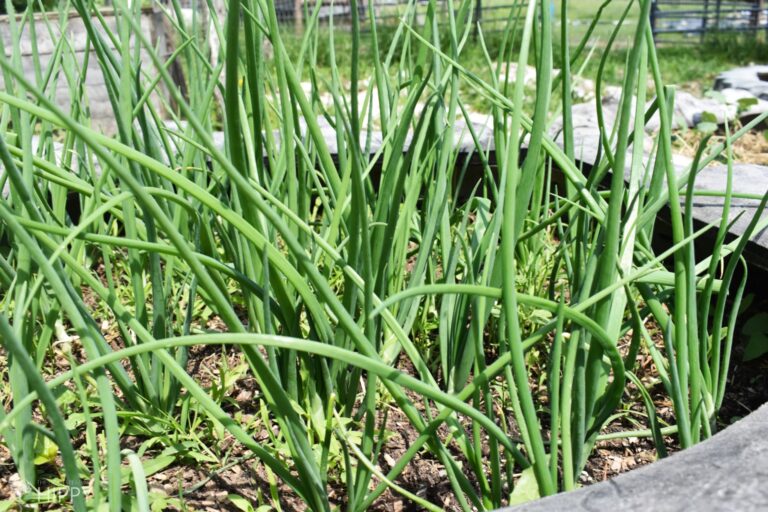
You can grow them inside, outside, in the garden, and even in containers. Keep reading for a guide on how to plant, grow, and harvest onions.
Table of Contents
Onion Benefits
An entire cup of raw, chopped onions contain only about 64 calories, no fat, 2 grams of protein, 3 grams of fiber, and no cholesterol.
You’ll find more than 10 percent of your daily recommended vitamin C and B-6, too, and don’t forget some iron, folate, magnesium, calcium, and antioxidants.
Onions have been touted for the natural health benefits.
For example, eating raw onions may be able to help build the immune system, lower bad cholesterol, prevent some forms of cancer, improve oral health, reduce oral pain, and regulate blood sugar.
With all of these benefits, the easy-to-grow-onion might just be a great choice for your garden or homestead.
Onion Basics
- Botanical name: allium cepa
- Plant type: Onions are an herbaceous biennial plant that happen to be in the amaryllis family.
- Growing season: Onions are typically a cold season crop. They are generally planted in the spring and harvested in the fall.
- Hardiness: Onions adapt well to different temperatures and are tolerant of frost.
The Best Location For Growing Onions
The best location for your onion plants is a spot in your garden that receives full sun and where the onions will not get shaded out by larger plants.
Consider using raised beds or rows that are at least four inches deep to give the plants enough room to develop their bulbs.
Onions do best with good crop rotation in order to prevent the spread of diseases and depletion of soil nutrients.
Basic Soil Requirements
Onions will be happy growing in just about any type of soil, from heavy clay to more optimal sandy loams.
They prefer a slightly acidic soil, with a pH from 5.5 to 6.5. Firm soil works well for onions, but if it is too heavy, you may want to add some compost to lighten the soil, add aeration, and increase its ability to retain moisture.
However, the soil should have good drainage because the onions will rot in very soggy soil.
Planting Onion Seeds
If you are looking for interesting onion varieties, you’ll want to consider planting onions from seed rather than from onion sets. Onion seeds do not preserve well for long periods of time, so make sure to use fresh seeds each year.
When you plant your onion seeds outdoors, you’ll want to space them six inches apart and in rows that are twelve inches apart.
This long season crop will take three to four months from direct sowing to harvest, so you may want to start onion seeds indoors in colder, more northern climates.
This will give you a longer growing season for your onions to mature.
Starting Onion Seeds Indoors
It’s easy to start onion seeds indoors in order to extend the outdoor growing season. Make sure your onion seeds are fresh. After the first year, onion seeds will not germinate as well as fresh seeds.
You’ll want to start them in February or March, depending on your last frost date. You can use this calculator to look up your last frost date.
Check your individual seed packets to find out how many weeks before the last frost date you can start your onion seeds.
Fill a flat tray with your typical seed starting mix and wet it down so that it is damp but not soggy. Imagine that the soil feels like a sponge that you have just wrung out – damp, but not dripping.
You may want to mix in 1 part vermiculite to four parts seed starting mix to increase the moisture retention of your mix. Sprinkle seeds over the mix, then cover them with up to a quarter inch of wet vermiculite.
If your seeds are warm enough, around 68 to 70 degrees Fahrenheit, your seeds should sprout within one to three weeks.
When each onion has three leaves, you can transplant them to a deeper container. Harden off your onions before transplanting them outside.
To harden off your onion seedlings, start putting them outside for a little bit at a time in a sheltered location.
Increase the amount of time the onions are outside for a week to two weeks, depending on how harsh the weather is.
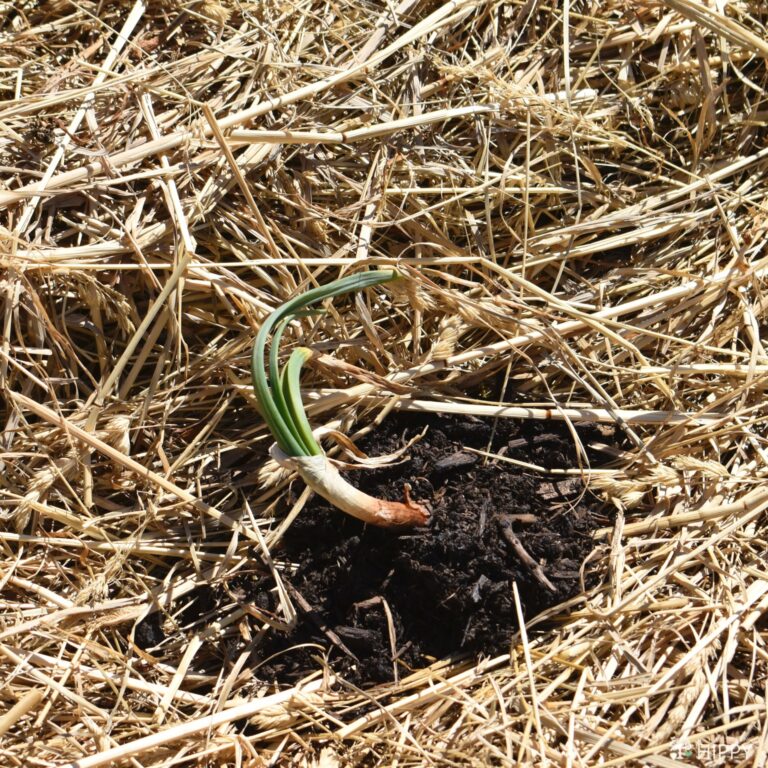
Direct Sowing Onion Seeds
You can direct sow your onion seeds in the garden in the spring once the soil is warm enough to be worked. Sow your seeds ¼ inch deep and about six inches apart.
Growing Onions from Onion Sets
Onion sets are tiny onions that were grown from seed, then stored in their dormant state for later use.
The benefit of planting from onion sets is that the onions will reach maturity faster than onions planted from seed. The onion sets may also produce larger bulbs.
Onions sets are easy to find at plant nurseries and even big box stores, but usually are produced in limited varieties.
If you want to use onion sets, you’ll want to plant the small bulbs no more than one inch deep in the garden. Space your bulbs two to six inches apart to give them enough room to grow and mature.
Transplanting
After you have hardened off your onion seedlings, you can transplant them right into your garden or raised bed. Dig a small hole, and carefully remove the onion from its container.
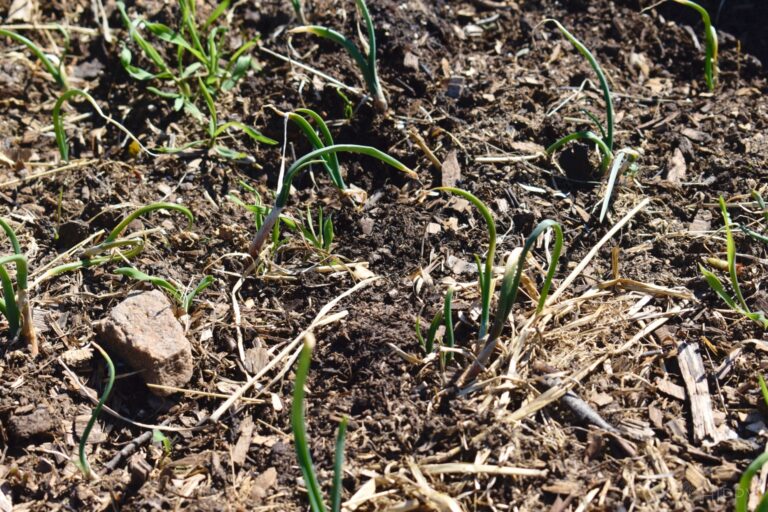
Take as much as the original soil as you can and be careful not to damage the tiny root system. Gently place the onion into the hole and push the soil back around the small onion plant. Give it a light watering.
Companion Planting
Onions can be companion planted with common herbs such as garlic, dill, savory, parsley, and chamomile.
You could also plant onions near peppers, spinach, lettuce, and beets. Onions will help repel insects, especially when planted near strawberries.
Do not plant your onions near cucumbers, corn, beans, beets, cabbage, or carrots.
Watering Onions and Onion Sets
The first few weeks after planting your onions, you’ll want to keep the soil moist until they are well-established.
Towards the end of the growing season, as the plants begin to mature, you’ll want to reduce watering when the tops start to fall over and no more new leaves appear.
This will signal the onions to go dormant and begin to dry. If you continue to water the onions heavily at this stage, the bulbs may rot instead of curing.
Fertilizing
Onions can be fertilized, but care should be taken not to use too much nitrogen-rich fertilizer. This can cause large tops but small bulbs. Too little potassium will shorten the shelf life of your onion bulbs.
For best results, use half strength fertilizer when you transplant your onions. In late springs, you can side-dress your rows of onions with compost or even fish emulsion.
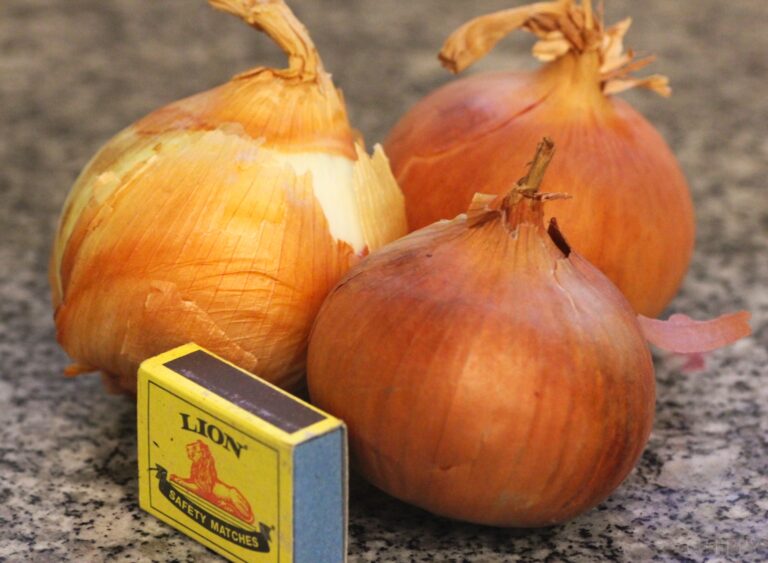
Harvesting
Onions should be harvested in late summer, before the cooler weather sets in. Otherwise, the mature onions may spoil in the cooler weather. As the onions begin to mature, the tops will turn yellow and begin to fall over
Reduce watering and pull the soil away from the onions to encourage them to begin drying.
Once the tops begin to dry, you can bend them down or stomp them down to help the onions finish ripening. When the tops are completely brown, you can pull the onions and prepare to cure them.
If any of the onions have sent up flower stalks, they will not store well but can be used in recipes within a few days.
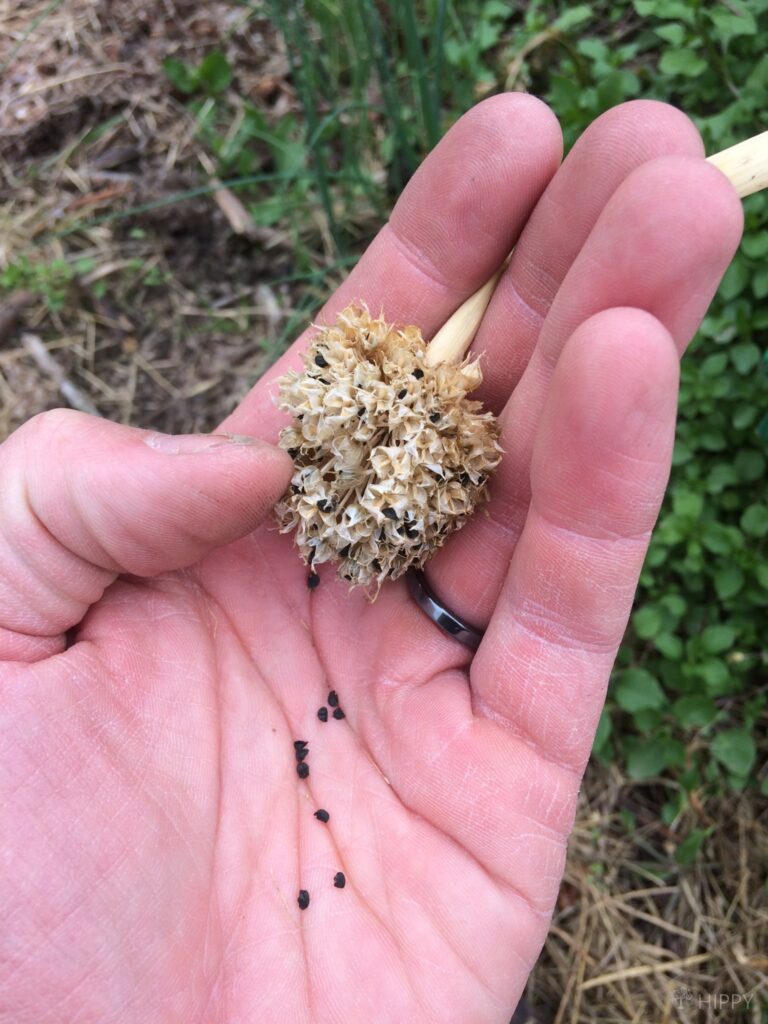
Saving Onion Seeds
Once you find a variety of onion that grows particularly well in your garden, you may want to save your own onion seeds for the following year.
You might want to avoid saving seeds from hybrid onions because you may not end up with the desired results.
Your best results will come from saving seeds from heirloom varieties of onion. Onion seeds are easy to save, but there are a few caveats to take into consideration.
Onions are biennial plants. They will only produce seeds in their second year. If you live in a climate with cold winters, and you want to save your own onion seeds, you will need to dig up your onion bulbs and store them between 45 and 55 degrees Fahrenheit.
Replant them in early spring and then watch for the flower stalks to appear.
When the flower heads begin to turn brown, you can clip them off and place them in a brown paper bag to finish drying.
This process should take a couple of weeks. Once the flowers are dry, shake the seeds out of the flower heads and store them for the following year.
Be sure to label and store your seeds in a cool, dry place. Moisture will ruin the delicate seeds. Keep in mind that onion seeds may not store well for more than a year.
Onion Varieties
There are many varieties of onions to choose from. Onions come in different sizes, colors, and flavors. They also come in short day, long day, and day neutral. You’ll need to know which type of onion grows in your location.
One critical factor in choosing what type of onion to plant is your location. Onions are bred based on the amount of daylight they receive, and if you choose an onion variety meant for a different location it might not grow and mature properly.
Summer days are longer in the north and shorter in the south. If you live in the northern area of the United States, you’ll want to plant long day onions.
If you live in the southern part of the United States, you’ll want to plant short day onions. Day neutral onions can be planted in either location.
Larger onions are often used for slicing, while small onions may be used for stews. Onions may be sweet or strong.
They come in yellow and red varieties. Some onions are better for storing and others are better when eaten fresh.
Long Day Onion Varieties
- ‘Walla-Walla’ is a large onion.
- ‘Ailsa Craig’ is also a large, long day onion.
- Choose Red Wing, Red Florence, and Southport Red if you want a red, long day onion.
- If you want an onion that stores well, try Sweet Sandwhich, Yellow Globe, or Copra.
Short Day Onion Varieties
- A nice Sweet Vidalia, short day onion choice is Yellow Granex.
- For long storing, short day onions, try Texas 1015-Y Supersweet or Red Creole.
- For mild flavor in a Short Day onion, choose White Bermuda.
Day Neutral Onion Varities
- For white, mild, large sweet bulbs, try Super Star.
- For a very large onion that stores well, choose Candy.
- Red Stockton is a large red onion that stores well.
Growing Onions in Containers
If you don’t have space for an inground garden or garden bed, you might consider growing some onions in a container on your patio. Onions will grow just fine in a container, but make sure you choose a spot that receives full sun.
Choose a large container and fill it with potting soil that contains slow-release fertilizer. You can plant your onions into your container when the soil temperature is around 60 degrees Fahrenheit.
Plant your onion sets or seedlings an inch or two apart and about an inch deep. Once the plants are growing, you can add some mulch, straw, or dried leaves to keep weeds down and retain moisture.
Water often enough to keep the soil moist but not soggy. You may need to fertilize your onions throughout the season. Otherwise, treat them as you would any onion that is growing in your gardens or raised garden beds.
Growing Onions Indoors
You can grow onions indoors, but you will want to choose a smaller variety that develops more quickly.
Prepare your pot with potting soil, just like you would if you were growing onions outside. Make sure to use a potting soil with time-release fertilizer or add your own to the mix. You could mix in some compost to lighten the soil or even some perlite to increase drainage.
Just as you would outside, plant the onion sets about one inch deep.
If you are growing the onions indoor in order to use the tops for cooking, you can plant the onions touching each other. They will make a pretty centerpiece on your table while they are growing.
If you want to wait to harvest the onions when they are larger, mature onions, leave at least two inches between them when you plant your onion sets.
Grow your onions in the sunniest window that you have. In the United States, this will probably be a south-facing window during the spring and summer months.
Keep the soil moist but not soggy. Don’t let the soil dry out completely. You may need to add grow lights if your onions aren’t receiving enough natural light.
You can succession plant onions throughout the year indoors, but use fresh potting soil often so that the nutrients are not depleted.
Onion Growing Problems
Your onions have plenty of leaves but no bulbs or small bulbs. This could be caused by too much nitrogen or planting at the wrong time or temperature.
- Onions are thick in the neck area but the leaf growth is stunted. This may be caused by a phosphorus or potassium deficiency. You can fertilize your onions or side dress your plants with compost to improve growth.
- Your onions have flowers and go to seed but the bulbs are hollow. The onions have put all of their energy into seed production. Cut off the flowers and stalks to encourage the plant to put its energy into growing the bulb rather than seeds.
- Your onion bulbs are very small but otherwise appear normal. This could be caused by planting the wrong variety of onion for your area. Your onions may also be competing with too many weeds for nutrients and not able to get enough water or nutrients to grow properly. Make sure you have chosen the correct type of onion for your location and be sure to remove weeds near your onions.
Pests
Onions have few problems with pests, except for thrips and onion maggots. You can discourage these pests by using row covers for the first few weeks. Do not plant onions out in the garden too early to discourage fly larvae.
Thrips
Thrips are tiny insects that are a tan color. If you find thrips on your onions, treat them with insecticidal soap. You will probably need two applications of insecticidal soap applied three days apart. Check the label for specific directions on how to apply insecticidal soap.
Onion Maggots
To prevent onion maggots, cover your onions with fine mesh netting such as row covers. Onion maggots are more prevalent during wet, rainy seasons than dry seasons.
Diseases
Onions are hardy vegetables, but are susceptible to some diseases, especially fungal diseases. Conditions that are too wet will cause onions to be more susceptible to fungal diseases and rotting.
Avoid overwatering and be sure your beds have good drainage to help prevent fungal diseases.
- Downy Mildew. Downy mildew looks like white mold on the leaves of your onions and will cause them to fall over. You can treat downy mildew with fungicide until bulbs begin to form.
- Leaf Blight. Leaf blight appears as white or golden specks. It spreads rapidly through the leaves and will kill the plant. Remove infected onions and seal them in a bag for disposal. If you catch leaf blight early, you may try to spray with a fungicide.
- Leaf Fleck. Leaf fleck is a fungal disease that is slow to spread. It appears as white or pale green flecks on the leaves. Leaf fleck won’t kill your onions.
- White Rot. White rot appears as tiny black dots. The leaves turn yellow and die. The plant will not have roots. This is the hardest and most difficult onion disease to stop. Remove infected plants and seal them in a bag for disposal. Plant any new onions away from the infected area and be careful not to cross-contaminate your soil.
- Pink Root. Pink Root is a fungal disease that stunts plant growth. It attacks the roots and causes the layers of the onion to turn pink and then purple. Use good crop rotation to prevent pink root.
- Onion Smut. This fungus is found on seedlings but not older plants. They may blister, grow strangely, or be stunted if they survive at all. Destroy the infected plants and do not use the same space for several years to prevent future infections.
Preservation
Once most of the tops of your onions have fallen over, it is time to harvest. Choose a time when the weather will be dry, so that you can cure the onions. Place them in a warm, dry place, out of the direct sun, for three weeks. Cut the tops back to one inch.
After your bulbs are cured, store them in a cool, dry place. Onions need good air circulation, so store them in mesh bags, or in boxes between layers of newspapers. Be sure to check for rotting or soft spots throughout the storage season.
Large sweet onions may only keep for a few weeks, but hard, pungent varieties will store for longer periods of time. Do not store onions near apples, pears, or tomatoes. These fruits give off ethylene gas, which causes stored onions to sprout.
Freezing Onions
Freeze onions by chopping them into small pieces. Place in a freezer-safe container and store in the freezer.
Dehydrating Onions
Onions can easily be dehydrated for storage. The simplest method for dehydrating onions is to use a home dehydrator.
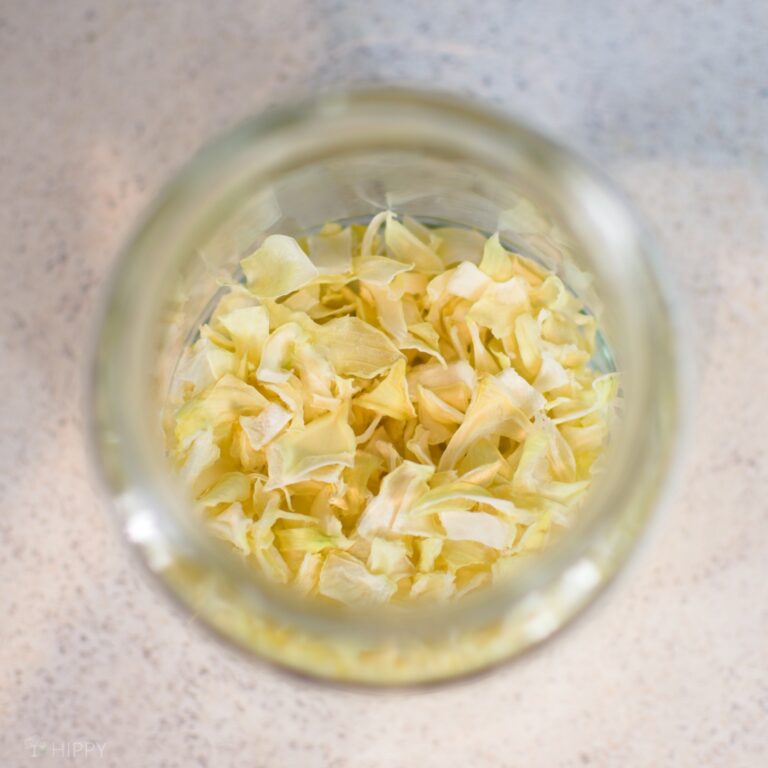
You may want to place your dehydrator in a garage, basement, or front porch in order to minimize the pungent smell.
Once the slices are dry, you can store them in glass jars. Check them after a few days to make sure there is no moisture in the jars. If there is, you may need to dehydrate them further.
If you wish, you can place your dried onions in a grinder to make minced onions or pulverize even further to create your own onion powder. These are great to add to soups, stews, or casseroles.
If you don’t have a dehydrator, you an dehydrate your onion slices in an oven. Place on cookie sheets and bake at 140 degrees Fahrenheit for 6 to 10 hours, until onions are crisp but not scorched.
Onion Recipes
Need a little inspiration for your onions? Try some of these easy and delicious onion recipes.
- Easy Quick Pickled Onions. If you have a few extra onions on hand, you can make this quick and easy recipe to top sandwiches, salads, and tacos.
- Marinated Slow Roasted Onions.
- Tennessee Onions. This recipe turns Sweet Vidalia onions into an amazing casserole.
- Caramelized Onions.
- Cheesy Onions. Try this dish to bring something new to your potlucks and family dinners.
- French Onion Soup. French onion soup is a delicious classic soup recipe.
Onion Growing FAQ
Can you plant a sprouted onion?
You can plant a sprouted onion but it will only grow more green sprouts, not more onions. The process is easy, and makes a great science experiment for kids, too.
- Fill a container with standard potting soil.
- Make a hole in the center that will fit your sprouted onion in it.
- Plant your onion in the hole.
- Choose a sunny spot to grow your sprouted onion and water it when the soil is dry.
- Cut off the greens as needed to use for cooking. Leave a couple inches of greens at the base of the onion to give them room to grow again.
Yes. You can eat onions that have sprouted, especially if the roots or shoots are still small. Sprouted onions are not toxic, but the shoots may taste bitter.
You can regrow onions from the bottoms. If you have an onion with a few roots, you can use the top part of the onion, and leave about half an inch with the roots attached.
Plant this (roots down) in a container of potting soil, and keep the soil moist. The onion will begin to regrow. You may get several sprouts that you can divide and plant that will grow into multiple onions.
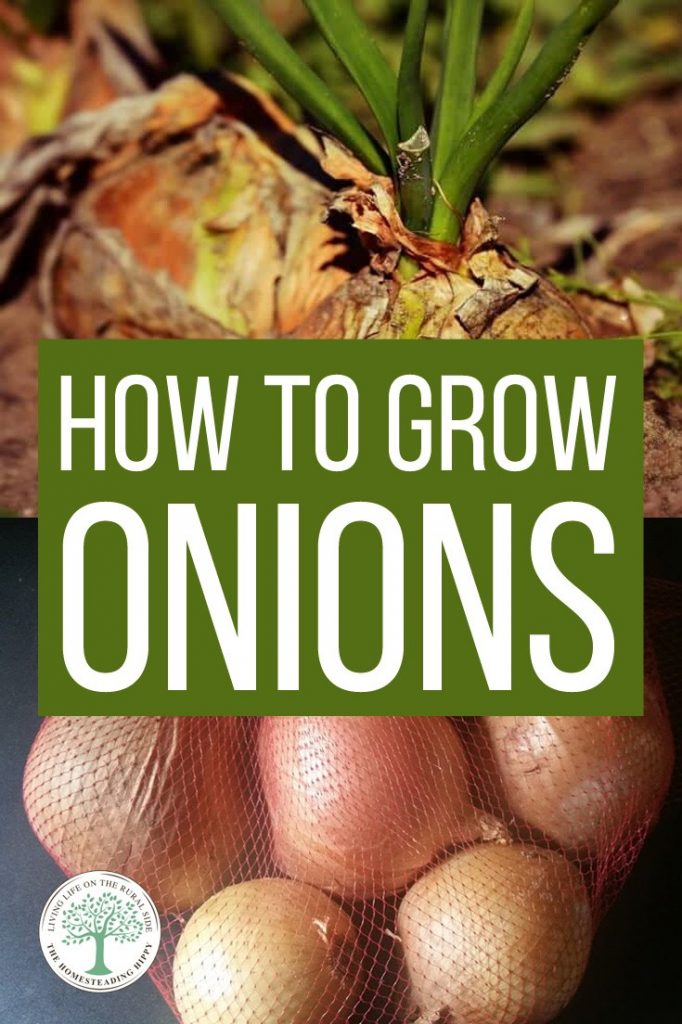

Amanda is a homesteader and a Jesus-loving, mother of 6 toddlers. She’s raising lots of fancy chickens and goats on her small homestead (among other things). Find out more about the team here.
